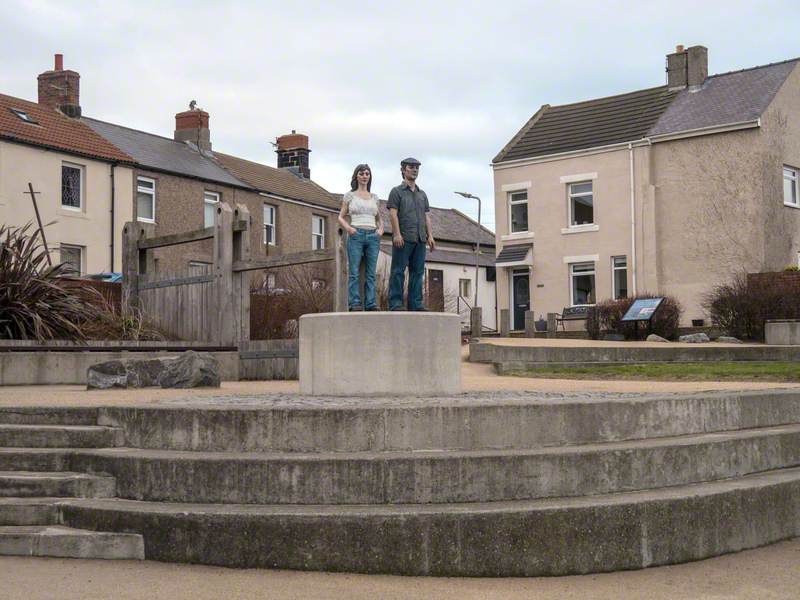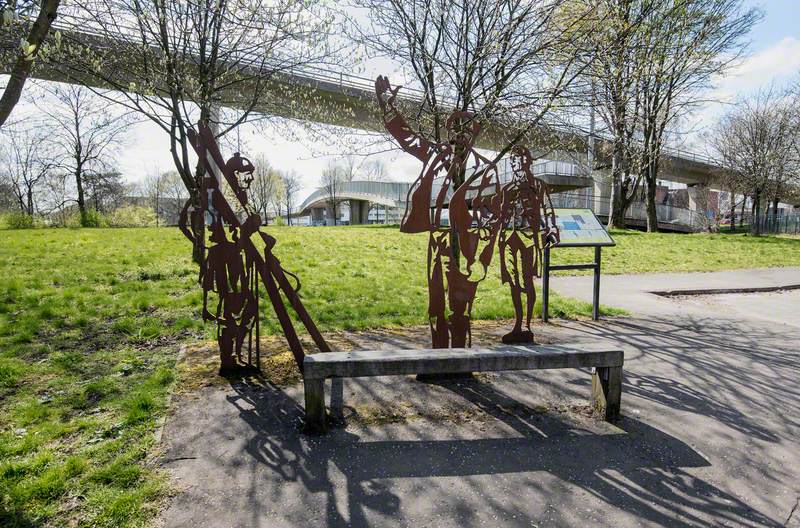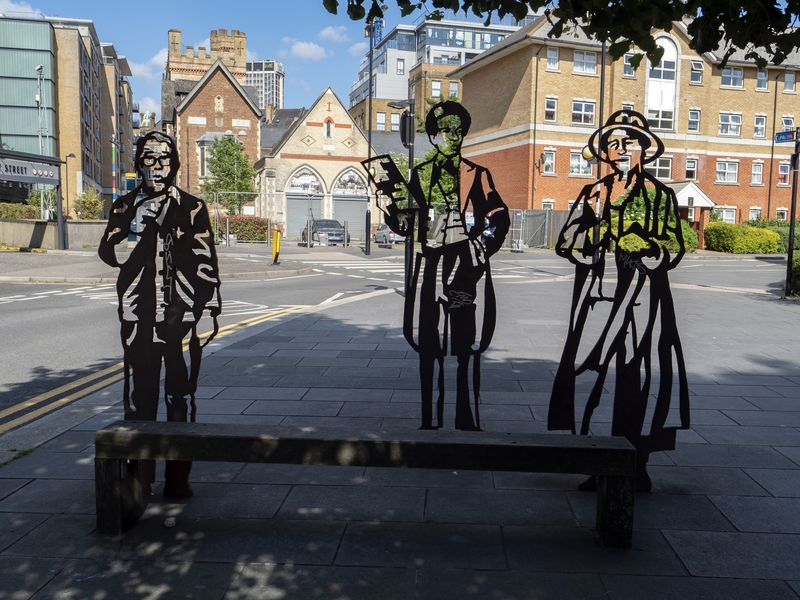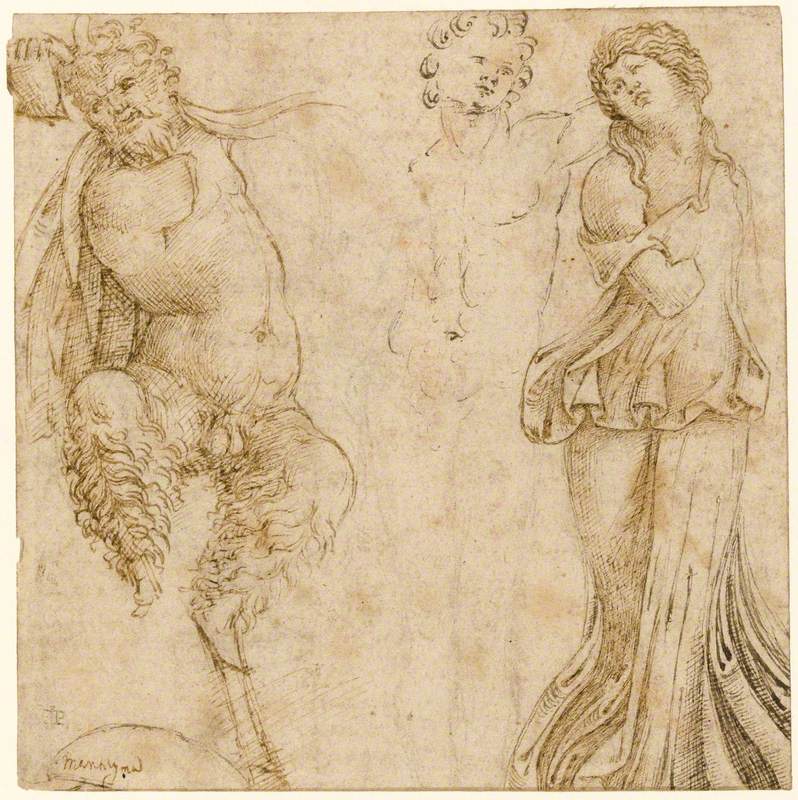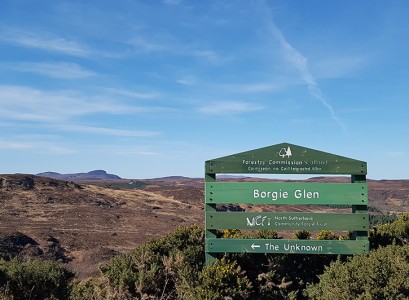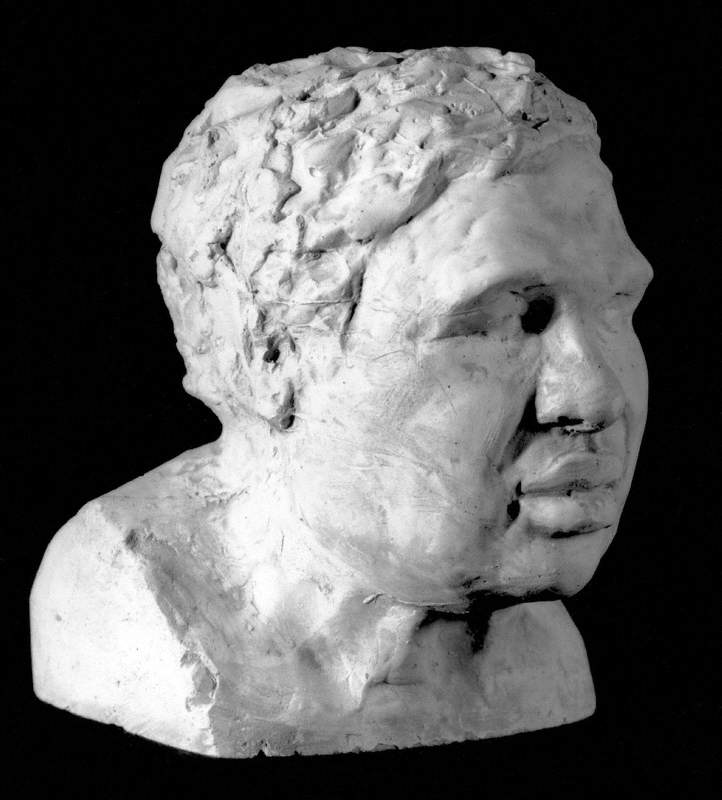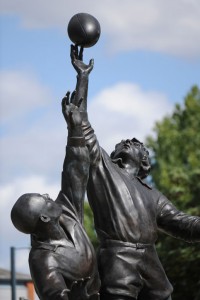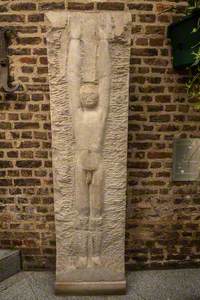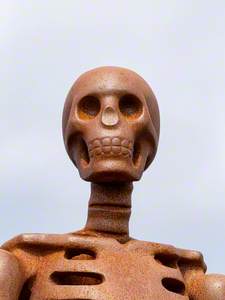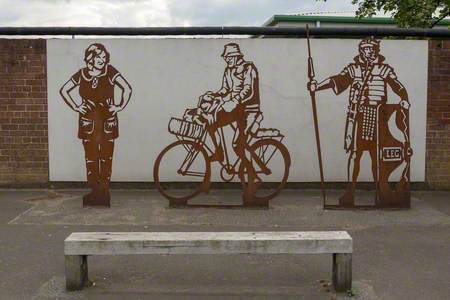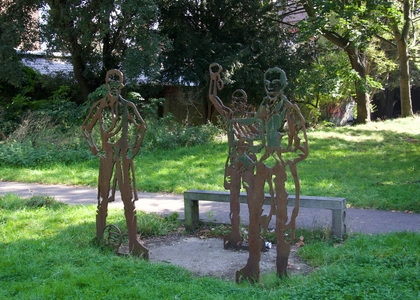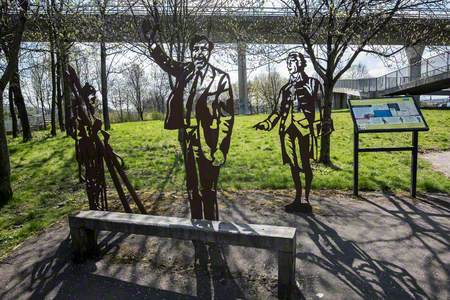You may have read when Art UK launched the sculpture project that there is a Rodin sculpture of the biblical Eve in Harlow – in front of Nandos. But, as you can see from this angle, it's also close to a Five Guys and indeed a Frankie and Benny's. How's that for temptation?
This Rodin isn't the only 'unexpected' public sculpture though – here are a few of the ones you may have missed.
Just like Eve, there are other sculptures situated by retail outlets across the country.
Also in Harlow, you can find Lynn Chadwick's Trigon by a Starbucks. Or perhaps that's just the name they wrote on the cup...
You can also find a Barbara Hepworth on the outside of Wagamama's in Cheltenham.
Theme and Variations
1969–1972
Barbara Hepworth, Morris Singer Art Foundry Ltd 
Made up of three bronze pieces, the sculpture was Hepworth's final public commission, and was designed to be part of the street scene, its character unfolding to the view from different angles and distances.
However, it wasn't Wagamama's who commissioned it. The building was originally the headquarters of the Cheltenham & Gloucester Building Society, opening in September 1972, and was later home to Feather & Blacks furniture store.
Hepworth's work can also be found on the John Lewis building on London's Oxford Street.
Moving to Belfast, you can see an Elisabeth Frink sculpture on the side of the Ulster Bank building, although many of the photographs on Art UK have building works taking place.
Flying Figures (Draft and Overdraft)
1963
Elisabeth Frink 
When she made them in the 1960s, Frink left the figures unnamed, although the locals soon named them 'Draft and Overdraft'.
To get up close and personal with a living legend, you just have to go shopping in Cardiff.
Sir Gareth Edwards (b.1947)
1982
John Bonar Dunlop 
Since 1982, this statue of Sir Gareth Edwards has been on display in the St David's shopping centre. Edwards is perhaps the greatest scrum-half to play rugby. His legendary 1974 try for the Barbarians against the All Blacks has been voted the best of all time.
As you can see from the photos, he's currently outside a Primark and Accessorize.
Gareth Edwards isn't the only public sculpture to be situated inside though. Here's an Eduardo Paolozzi sculpture in Chelsea and Westminster Hospital.
The sculpture is also unusual in that it's functional – it's a collection box.
If you happen to be taking a break in the cafe at London's Holland Park, you'll find an early Jacob Epstein.
Although unfinished and left untitled by the sculptor, it's now known as Sun Worshipper. It was probably made as a study for an unrealised pagan temple Epstein was working on with Eric Gill – they collaborated on the monument for Oscar Wilde's grave at Père Lachaise Cemetery in Paris.
Sometimes you just come across a sculpture when you least expect it.
If you happen to be at the very far end of platform two at Stoke-on-Trent railway station, you'll find Hand with Chronos by Vincent Woropay (1951–2002).
Different sources say it was either commissioned by British Rail and unveiled in 1988, or commissioned for the National Garden Festival at Gateshead in 1990 and then later moved to the station. Either way, it's not something you'd usually expect to find waiting for a train, but you can read more about it in this story.
Perhaps even more unexpected is Kenny Hunter's large figure called The Unknown.
It stands in the Scottish Highlands and you can read more about it in this story.
Staying in remote parts of Scotland, you might come across this hut on North Uist in the Western Isles.
Both Nam Faileas: Hut of the Shadow
1998
Chris Drury 
It's called Both Nam Faileas: Hut of the Shadow and was created by Chris Drury. It's actually part of the Taigh Chearsabhagh Museum & Arts Centre and the hut acts as a camera obscura with a lens and mirrors projecting the landscape outside onto a large stone inside.
You might think that a Henry Moore sculpture would be familiar and instantly recognisable – large forms often dominating the landscape. However, here on St Andrew's church in Much Hadham, Hertfordshire, you can find an atypical work.
Either side of the west doorway, you can see the heads of a king and queen. They were created in 1953 and there's also a stained glass window designed by Moore.
If you really want the unexpected, head to Seaton Valley in Northumberland and there you'll find this sculpture.
Essentially a large spoon in a field, it is part of the South East Northumberland Public Art and Design Initiative 'Inspire', connecting Cramlington and the villages of Seghill and Seaton Delaval. The artist believed that a place where food is produced was the best place to locate the spoon – and who are we to argue?
So far, several of our sculptures have been on plinths or buildings. Some are designed to be at ground level and depict their subjects as part of the landscape.
Awesome aviator Amy Johnson walks by in Herne Bay in Kent – the scene of her tragic death, serving her country...
...while Cary Grant is in a hurry in Bristol, all suited up and carrying his script for Alfred Hitchcock's To Catch A Thief.
Cary Grant (1904–1986)
2001 or before
Graham Ibbeson, A. B. Fine Art Foundry 
Photography pioneer Henry Fox-Talbot takes a snap on the green at Chippenham in Wiltshire.
William Henry Fox Talbot (1800–1877)
1993
Greta Berlin 
...and the Bee Gees in Douglas on the Isle of Man where the trio were born. Can you tell by the way they use their walk they're women's men, no time to talk?
Sculptor Andy Edwards has done a similar trick on the docks at Liverpool, with the Fab Four immortalised in bronze.
Like the brothers Gibb on Man, the Beatles stride confidently forward, exuding that air of youthful swagger that made them massive.
Perhaps an even more extreme version of sculpture at ground level is where it's actually flat on the ground.
This 'grave' artwork consists of two coffin shapes set into the ground.
An Invitation to Dance on the Grave… Grimaldi/Dibdin
2010
Henry Louis Krokatsis 
The public are invited to dance on a series of bronze tiles that sit on top of Grimaldi's and Dibdins 'graves'. As they dance, the tune 'Hot Codlins' plays. The artist said that he 'wanted to create a joyous interlude from the silence of death'.
Renowned sculptor Antony Gormley doesn't ask you to dance on anyone's grave (real or otherwise), but he has installed this in Cambridge.
It consists of a human figure buried upside down with only the soles of the feet showing.
One of Gormley's more famous works is Another Place – the figures that stand on Crosby Beach.
As the tide changes, the sculptures are submerged. It's just one example of sculptures you can find actually in the sea or bodies of water.
This couple by Sean Henry at Newbiggin Bay in Northumberland look like they are standing on the water at high tide. They look towards their counterparts (another sculpture) on land.
The tide is a crucial part of this artwork too, in Na h-Eileanan an Iar, Bosta in the Western Isles.
Played by the movement of the waves and tides, the bell creates a constantly varying musical pattern, serving also as a long-term marker of rising sea levels.
Instead of the sea, this sculpture is now located in a loch in Coatbridge, having been moved from behind the visitor centre. It is perhaps even more spectacular when the loch freezes!
Between the Devil and the Deep Blue Sea
1986
Neil McLeod 
It could be said that the opposite of hiding in the ground or out to sea is placing sculpture on the roof.
Elisabeth Frink's Desert Quartet is situated in Worthing, West Sussex. Commissioned by the Avon Group property developers, the works sit on top of a colonnade at the back of the Montague shopping centre.
These wind towers are located on the top of Inverness's Eden Court Theatre – a large theatre, cinema and arts venue. They are actually eco-friendly, using wind to ventilate the venue, incorporating sustainability and art into the building's design.
After all that sculpture spotting, you might want a quiet sit down. But that doesn't mean you've escaped. Up and down the country there are benches with portraits of local figures, manufactured by Sustrans.
The one in South Shields features comedian Sarah Millican, a Roman soldier (Hadrian's Wall is nearby) and Norman Fay, a local cycle frame builder.
Down the other end of England, the Dover bench portrays singer Vera Lynn, author Ian Fleming and Jamie Clark, a torchbearer for the 2012 Olympics.
Portrait Bench (Vera Lynn, Ian Fleming and Jamie Clark)
2013
unknown artist 
St Helens has comedian Johnny Vegas, rugby league player Steve Prescott, and an anonymous glass blower...
...while Haringey has statues of Olympic gold medallist Nicola Adams, war hero and the first black football player for Tottenham Hotspur, Walter Tull, and the 'father of meteorology', Luke Howard.
Leeds also has Nicola Adams, plus cycling champion Beryl Burton, and – rather brilliantly – a water vole.
Glasgow goes for the engineer and inventor James Watt, trade unionist Jimmy Reid, and author and broadcaster Tom Weir.
Croydon has the triumvirate of Ronnie Corbett, actress Dame Peggy Ashcroft and composer Samuel Coleridge-Taylor.
But perhaps the most unexpected seating/sculpture of them all is this three-sided stone bench in Faringdon in Oxfordshire.
Created by Timothy Shutter, it incorporates a deep-sea diver and a quotation from local eccentric Lord Berners. It celebrates the friendship between Salvador Dalí and Lord Berners who hired the deep-sea diving suit for Dalí to wear at the opening of the first surrealist art exhibition in London.
Dalí is reputed to have first tried out the diving suit in the streets of Faringdon. He claimed the diving suit represented his exploration of the subconscious.
Bet you didn't expect that! Take a look at our growing treasure trove of public sculptures and see if you can spot any unusual ones yourself.
Andrew Shore, Head of Content at Art UK





